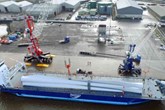New joint industry project to standardise offshore wind geospatial data management
Published by Abby Butler,
Editorial Assistant
Energy Global,
The Carbon Trust has launched the Unison Project, which will develop a standardised offshore wind data model to support safer, faster, and more cost-effective construction of offshore wind farms.
The Unison Project is led by a consortium of 12 major offshore wind developers and industry stakeholders and will be delivered by the Carbon Trust.
The rapid expansion of the offshore wind industry has led to a surge in demand for geospatial data services that support offshore site development, with a growing number of contractors and developers producing and exchanging data. However, the lack of standardisation in how data is structured and shared can lead to inefficiencies, increased project costs and elevated risks during construction.
The offshore wind data model will serve as a template for managing and exchanging GIS data during the construction phase of offshore wind projects.
Through the Unison Project, the Carbon Trust will deliver:
- A standardised, open-source data model, published on the Carbon Trust website.
- Technical documentation and guidance, including a data dictionary and model diagrams.
- Workshops and presentations to promote industry-wide adoption.
The project builds on successful data standardisation efforts in the oil and gas sector but will be tailored to addressing the needs of offshore wind construction.
Patricia Teixeira, Principal GIS Specialist at Ørsted, commented: “Collaboration is often a catalyst for industry progress, unlocking expertise that accelerates innovation and helps set shared standards. What started as an idea of sharing Ørsted’s proprietary construction data model became the spark for something bigger. Ørsted shared it with the industry, invited collaboration, and brought together partners across the value chain. Through countless conversations, engagement and effort the idea has grown into what is now UNISON which will set a new standard for how we work together, ultimately advancing efficiency, sustainability and safety. Together, we are bringing the idea to life.”
Arnaud Vidal, Data and Digital Technologies/Head of Geospatial at TotalEnergies, added: “Unison Project represents a pivotal step forward in offshore wind geospatial data management. By establishing a standardised and open-source GIS data exchange model, it streamlines collaboration across developers, contractors, and technical partners. This harmonisation reduces costs associated with data duplication, format inconsistencies, and operational delays, while enhancing data reliability and traceability. Ultimately, it enables better risk control and more efficient capital deployment throughout the construction lifecycle.”
Anthony Hunt, Head of GIS Team in BA Wind at Vattenfall, noted: “At Vattenfall we are committed to standardisation and continuous improvement as key drivers when working with spatial data. We are pleased to support wider industry initiatives that promote standardised practices leading to increased efficiency and quality while bringing cost reductions.”
Barend Vos, Geospatial Specialist at Shell, responded: “Shell welcomes an integrated offshore wind construction data model, as it will drive cost savings by optimizing planning and execution while providing clear insights into the financial implications of design, logistics, and risk management decisions.”
Caroline Coccoli, Senior Manager at the Carbon Trust, concluded: “As the industry faces economic headwinds, the Unison Project shows that meaningful progress does not always require massive investment. It is exactly the kind of targeted innovation needed, and it builds on the Carbon Trust’s strong track record in supporting standardisation across the offshore wind sector.”
The Unison Project is the latest joint industry project (JIP) to be initiated by the Carbon Trust’s world-leading Offshore Wind Innovation Platform, which includes innovation programmes such as the Offshore Wind Accelerator and Floating Wind JIP. The idea was proposed by Ørsted and received strong support from 11 other leading offshore wind developers. It is expected to run for 14 months, concluding in autumn 2026.
The consortium includes the following organisations:
- The Carbon Trust.
- EnBW.
- Equinor.
- Flotation Energy.
- Jera Nex BP.
- Ørsted.
- Ocean Winds.
- RWE.
- Scottish Power Renewables.
- Shell.
- SSE Renewables.
- TotalEnergies.
- Vattenfall.
A technical review group and other stakeholders will provide expert input and support dissemination of the project outputs.
For more news and technical articles from the global renewable industry, read the latest issue of Energy Global magazine.
Energy Global's autumn 2025 issue
Explore the latest insights into the renewable energy sector in the autumn issue of Energy Global, out now! This edition features a regional report on the Asia Pacific from Aurora Energy Research, mapping out why the wholesale price cap is detrimental to the energy transition in India. The issue then delves into articles covering crucial topics such as digitalisation in renewables, inspection & maintenance, developments in floating offshore wind, coatings, solar optimisation and more. Contributors include Flotation Energy, DNV, Sarens, Neuman & Esser, Teknos, and more, so this issue is not one to miss!
Read the article online at: https://www.energyglobal.com/wind/31102025/new-joint-industry-project-to-standardise-offshore-wind-geospatial-data-management/
You might also like
Ports are the backbone of Europe’s wind energy
The WindEurope Ports Platform meeting in Ireland has highlighted the importance of port investments to wind energy.

